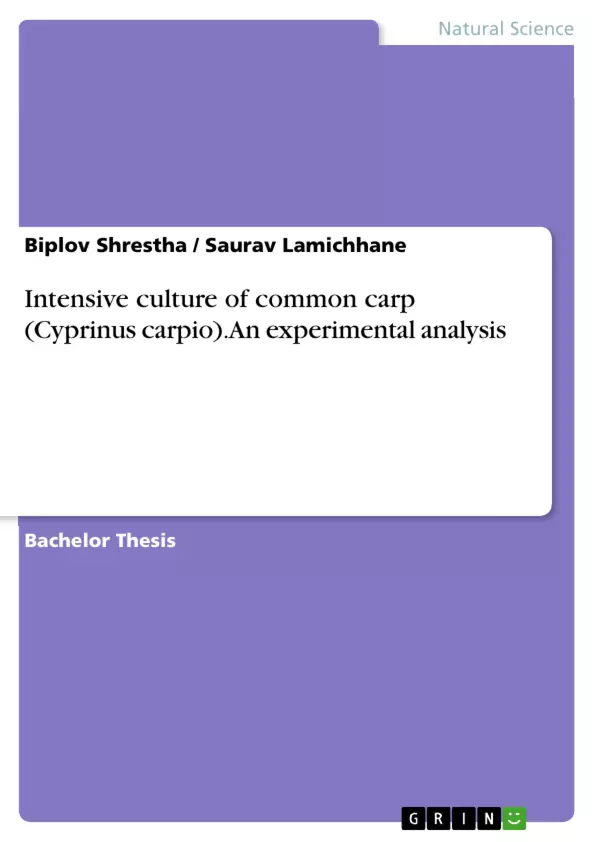In this study, intensive common carp (Cyprinus carpio) culture was conducted from 2nd October to 28th October in experimental cemented tank of 25 m2 of Fish hatchery complex, AFU to learn to produce common carp through intensive culture.
Intensive culture is a system where fish are culture in a well-managed manner and this system includes small ponds, tanks, and raceways with very high stocking density. In this system, fish is almost completely fed on formulated feed and good management is undertaken for controlling all aspects which require proper growth. Production of common carp is increasing so, intensification of its production from extensive to semi-intensive and intensive aquaculture systems is a new trend.
The stocking density was 250 fish at the rate of 10 fish/m2. Average body weight of 27.9±9.8 g fish were stocked in the tank and feeding was done at 3% of body weight. Feed was made from mustard oil cake (70%) and rice bran (30%), a feeding tray having an area of 50x50 cm2 was used for feeding.
Sampling was performed at a ten days interval and feeding was adjusted accordingly. The average temperature, DO and pH of the culture tank of 5:30 am and 3pm was 28.7±0.9 and 30.2±1.2°C, 7.1±1.3 and 12.4±1.6 mg/L, 7.7 and 7.8 respectively which were within the suitable range for culturing. After harvesting, the total harvested weight of fish was 12.9 kg while total stocking weight was 7.4 kg. Mean harvest weight of fish was 54.4±28.6 g while mean stocking weight was 27.9±9.8 g.
The survival rate of fish was 97.6%. The extrapolated GFY and NFY obtained was 72.6 and 30.8 t/ha/year respectively. The fish were handed over to Aquaculture farm, AFU which they will rear further in tanks and ponds. During culturing water was exchanged daily in the morning for maintaining proper water quality. Thus, the results suggested that common carp intensive farming is feasible in cemented tanks with good survival rate.
Table of Contents
- ACRONYMS
- ABSTRACT
- 1.1 General introduction
- 1.2 Objectives
- General objective
- Specific objectives
- 1.3 Limitation
- 2 LITERATURE REVIEW
- 2.1 Intensive culture
- 2.2 Global status of aquaculture and common carp
- 2.3 Habitat and biology
- 2.4 General morphology
- 2.5 Water quality parameters
- 2.6 Nutritional requirement of Common carp
- 2.7 Feed and feeding behavior
- 2.8 Water quality management
- 3 MATERIALS AND METHODS
- 3.1 LEE site
- 3.2 Tank preparation
- 3.3 Procurement and stocking of fingerlings
- 3.4 Tank management
- 3.4.1 Feeding
- 3.4.2 Water quality management and parameter
- 3.5 Fish sampling
- 3.6 Fish harvesting and marketing
- 3.7 Analytical methods
- 3.7.1 Fish growth parameters
- 3.7.2 Gross margin calculation
- 3.7.3 Statistical analysis
- 4 RESULTS
- 4.1 Water quality parameters
- 4.2 Water exchange
- 4.3 Fish growth and production parameters
- 4.4 Gross margin analysis
- 5 DISCUSSION
- 5.1 Water quality
- 5.2 Growth and production
- 6 CONCLUSION
- REFERENCES
- APPENDICES
Objectives and Key Themes
This study aimed to investigate the feasibility of intensive common carp culture in cemented tanks. The research focused on the growth and production parameters of the fish, the water quality management, and the overall economic feasibility of the system.
- Intensive Common Carp Culture
- Growth and Production Parameters
- Water Quality Management
- Economic Feasibility
- Survival Rate and Harvest Weight
Chapter Summaries
The introduction provides a general overview of intensive fish culture and its importance in the global context. It outlines the specific objectives of the study, focusing on the feasibility of intensive common carp culture. The literature review explores existing knowledge on intensive culture, global aquaculture trends, the biology of common carp, water quality management, feeding practices, and nutritional requirements. The materials and methods section details the experimental setup, including the site, tank preparation, stocking density, feeding regime, water quality monitoring, and sampling procedures. The results chapter presents data on water quality parameters, fish growth, production parameters, and economic analysis. The discussion section analyzes the findings in relation to previous research and explores the implications for future aquaculture practices. The conclusion summarizes the key findings and discusses the feasibility of intensive common carp culture in cemented tanks.
Keywords
Intensive aquaculture, common carp, Cyprinus carpio, growth, production, water quality, feeding, economic feasibility, survival rate, harvest weight.
- Quote paper
- Biplov Shrestha (Author), Saurav Lamichhane (Author), 2020, Intensive culture of common carp (Cyprinus carpio). An experimental analysis, Munich, GRIN Verlag, https://www.grin.com/document/1128315



